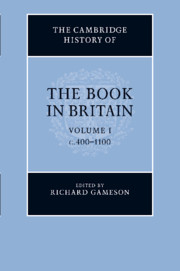Book contents
- Frontmatter
- 1 From Vindolanda to Domesday: the book in Britain from the Romans to the Normans
- PART I THE MAKING OF BOOKS
- 2 The material fabric of early British books
- 3 Anglo-Saxon scribes and scriptoria
- 4 Writing in the Insular world
- 5 Script in Wales, Scotland and Cornwall
- 6 English vernacular script
- 7 Latin script in England c. 900–1100
- 8 The design and decoration of Insular gospel-books and other liturgical manuscripts, c. 600 – c. 900
- 9 The decoration of the earliest Welsh manuscripts
- 10 Book decoration in England, c. 871 – c. 1100
- 11 Bookbindings
- PART II THE CIRCULATION OF BOOKS
- PART III TYPES OF BOOKS AND THEIR USES
- PART IV COLLECTIONS OF BOOKS
- PART V CODA
- Bibliography
- Concordance of named manuscripts
- Index of manuscripts
- General Index
- Plate 4.1: The Lindisfarne Gospels"
- Plate 5.1: The Lichfield/St Chad Gospels"
7 - Latin script in England c. 900–1100
from PART I - THE MAKING OF BOOKS
Published online by Cambridge University Press: 28 March 2012
- Frontmatter
- 1 From Vindolanda to Domesday: the book in Britain from the Romans to the Normans
- PART I THE MAKING OF BOOKS
- 2 The material fabric of early British books
- 3 Anglo-Saxon scribes and scriptoria
- 4 Writing in the Insular world
- 5 Script in Wales, Scotland and Cornwall
- 6 English vernacular script
- 7 Latin script in England c. 900–1100
- 8 The design and decoration of Insular gospel-books and other liturgical manuscripts, c. 600 – c. 900
- 9 The decoration of the earliest Welsh manuscripts
- 10 Book decoration in England, c. 871 – c. 1100
- 11 Bookbindings
- PART II THE CIRCULATION OF BOOKS
- PART III TYPES OF BOOKS AND THEIR USES
- PART IV COLLECTIONS OF BOOKS
- PART V CODA
- Bibliography
- Concordance of named manuscripts
- Index of manuscripts
- General Index
- Plate 4.1: The Lindisfarne Gospels"
- Plate 5.1: The Lichfield/St Chad Gospels"
Summary
Square Minuscule
English Square Minuscule is a formalised development of the compressed angular minuscule scripts in use in England in the eighth and ninth centuries. Used throughout the tenth century, it is found in some eighty surviving manuscripts with texts in both Latin and Old English, in some fifty royal and private charters, and for entries (including Old English documents) copied into manuscripts whose main texts are in other scripts. All of these specimens seem to have been written south of a line running from the Thames to the Severn (for examples, see Plates 7a.1–3 at the back of this volume).
In the reign of Alfred multiple copies of vernacular translations were distributed through Wessex and Mercia as part of a programme to use Old English as a medium for instruction. The Latin originals were most probably written in Insular Half-Uncial or in Caroline Minuscule; however, the translations were presumably copied at Alfred’s court using the compressed pointed minuscule which had become the standard script for books and documents in Wessex. The morphology of Square Minuscule owes much to the competing influences of all these earlier forms of writing, and to the desire to establish a distinctive script which did not require undue scribal dexterity, in contrast to the calligraphic minuscules that had been used in Wessex before Alfred’s reign.
Keywords
- Type
- Chapter
- Information
- The Cambridge History of the Book in Britain , pp. 187 - 224Publisher: Cambridge University PressPrint publication year: 2011



